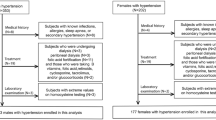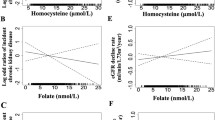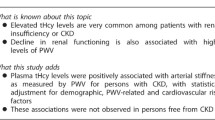Abstract
That plasma homocysteine is elevated markedly in renal dysfunction is well recognized. But whether the increased homocysteine is an independent correlate of glomerular filtration rate, a marker of renal function, in asymptomatic younger individuals is not clear. The aim of this study was to determine the association between plasma homocysteine and renal function in a biracial (black–white) community-based cohort of asymptomatic young adults. Plasma homocysteine along with cardiovascular disease risk factor variables were measured in 805 white and 330 black subjects, ages 24–44 years, enrolled in the Bogalusa Heart Study. Modification of Diet in Renal Disease Study equation was used to calculate the estimated glomerular filtration rate (eGFR) from serum creatinine level. Males versus females showed higher homocysteine levels (8.83 ± 3.16 vs. 7.35 ± 2.84 μmol/L, p < 0.0001) and lower eGFR (99.1 ± 17.6 vs. 102.5 ± 21.0 mL/min/1.73 m2, p = 0.024). Whites versus blacks had lower eGFR (97.3 ± 18.0 vs. 110.0 ± 20.6 mL/min/1.73 m2, p < 0.0001). In a multivariate regression analysis that included age, race, sex, body mass index, blood pressure, lipoprotein variables, insulin resistance index and homocysteine, white race, age and homocysteine, in that order, were independently and negatively associated with eGFR. The odds ratio (95% confidence interval) of individuals in the homocysteine quintiles II, III, IV and V vs. I for having the risk of impaired eGFR defined as <10th percentile was 2.28 (0.95–5.50, p = 0.065), 2.97 (1.24–7.12, p = 0.015), 3.32 (1.45–7.60, p = 0.005) and 6.99 (3.06–15.94, p < 0.0001), respectively. Homocysteine is an independent correlate of renal function in asymptomatic black and white young adults.

Similar content being viewed by others
References
Pizzolo F, Friso S, Olivieri O, et al. Homocysteine, traditional risk factors and impaired renal function in coronary artery disease. Eur J Clin Invest. 2006;36:698–704. doi:10.1111/j.1365-2362.2006.01714.x.
Boushey CJ, Beresford SA, Omenn GS, Motulsky AG. A quantitative assessment of plasma homocysteine as a risk factor for vascular disease. Probable benefits of increasing folic acid intakes. JAMA. 1995;274:1049–57. doi:10.1001/jama.274.13.1049.
McCullough PA, Li S, Jurkovitz CT, et al. Chronic kidney disease, prevalence of premature cardiovascular disease, and relationship to short-term mortality. Am Heart J. 2008;156:277–83. doi:10.1016/j.ahj.2008.02.024.
Sarnak MJ, Levey AS, Schoolwerth AC, et al. Kidney disease as a risk factor for development of cardiovascular disease: a statement from the American Heart Association Councils on kidney in cardiovascular disease, high blood pressure research, clinical cardiology, and epidemiology and prevention. Circulation. 2003;108:2154–69. doi:10.1161/01.CIR.0000095676.90936.80.
Bostom AG, Culleton BF. Hyperhomocysteinemia in chronic renal disease. J Am Soc Nephrol. 1999;10:891–900.
Friedman AN, Bostom AG, Selhub J, Levey AS, Rosenberg IH. The kidney and homocysteine metabolism. J Am Soc Nephrol. 2001;12:2181–9.
Rodionov RN, Lentz SR. The homocysteine paradox. Arterioscler Thromb Vasc Biol. 2008;28:1031–3. doi:10.1161/ATVBAHA.108.164830.
Samuelsson O, Lee DM, Attman PO, et al. The plasma levels of homocysteine are elevated in moderate renal insufficiency but do not predict the rate of progression. Nephron. 1999;82:306–11. doi:10.1159/000045445.
Hovind P, Tarnow L, Rossing P, et al. Progression of diabetic nephropathy: role of plasma homocysteine and plasminogen activator inhibitor-1. Am J Kidney Dis. 2001;38:1376–80. doi:10.1053/ajkd.2001.29261.
Francis ME, Eggers PW, Hostetter TH, Briggs JP. Association between serum homocysteine and markers of impaired kidney function in adults in the United States. Kidney Int. 2004;66:303–12. doi:10.1111/j.1523-1755.2004.00732.x.
Schäfer SA, Müssig K, Stefan N, Häring HU, Fritsche A, Balletshofer BM. Plasma homocysteine concentrations in young individuals at increased risk of type 2 diabetes are associated with subtle differences in glomerular filtration rate but not with insulin resistance. Exp Clin Endocrinol Diabetes. 2006;114:306–9. doi:10.1055/s-2006-924073.
Robles NR, Sanchez Munoz-Torrero JF, Garcia Gallego F, Velasco Gemio J, Escola JM. Homocysteinemia in hypertensive patients with renal target organ damage (mild renal dysfunction). Eur J Med Res. 2008;13:196–9.
Foley RN, Wang C, Collins AJ. Cardiovascular risk factor profiles and kidney function stage in the US general population: the NHANES III study. Mayo Clin Proc. 2005;80:1270–7. doi:10.4065/80.10.1270.
Berenson GS, McMahan CA, Voors AW, Webber LS, Srinivasan SR, Frank GC, et al. In: Andrews C, Hester HE, editors. Cardiovascular risk factors in children—the early natural history of atherosclerosis and essential hypertension. New York: Oxford University Press; 1980. p. 47–123.
Shipchandler MT, Moore EG. Rapid, fully automated measurement of plasma homocyst(e)ine with the Abbott IMx analyzer. Clin Chem. 1995;41:991–4.
Allain CC, Poon LS, Chan CSG, Richmond W, Fu PC. Enzymatic determination of total serum cholesterol. Clin Chem. 1974;20:470–4.
Srinivasan SR, Berenson GS. Serum lipoproteins in children and methods for study. In: Lewis LA, editor. CRC handbook of electrophoresis vol III: lipoprotein methodology and human studies. Boca Raton, FL: CRC Press; 1983. p. 185–203.
Levey AS, Coresh J, Balk E, et al. National kidney foundation practice guidelines for chronic kidney disease: evaluation, classification, and stratification. Ann Intern Med. 2003;139:137–47.
Matthews DR, Hosker JP, Rudenski AS, Naylor BA, Treacher DF, Turner RC. Homeostasis model assessment: insulin resistance and beta-cell function from fasting plasma glucose and insulin concentrations in man. Diabetologia. 1985;28:412–9. doi:10.1007/BF00280883.
Bostom AG, Lathrop L. Hyperhomocysteinemia in end-stage renal disease: prevalence, etiology, and potential relationship to arteriosclerotic outcomes. Kidney Int. 1997;52:10–20. doi:10.1038/ki.1997.298.
Yi F, Li PL. Mechanisms of homocysteine-induced glomerular injury and sclerosis. Am J Nephrol. 2008;28:254–64. doi:10.1159/000110876.
Brattström L, Lindgren A, Israelsson B, Andersson A, Hultberg B. Homocysteine and cysteine: determinants of plasma levels in middle-aged and elderly subjects. J Intern Med. 1994;236:633–41.
Chen YF, Li PL, Zou AP. Effect of hyperhomocysteinemia on plasma or tissue adenosine levels and renal function. Circulation. 2002;106:1275–81. doi:10.1161/01.CIR.0000027586.64231.1B.
Gill PS, Wilcox CS. NADPH oxidases in the kidney. Antioxid Redox Signal. 2006;8:1597–607. doi:10.1089/ars.2006.8.1597.
Werstuck GH, Lentz SR, Dayal S, et al. Homocysteine-induced endoplasmic reticulum stress causes dysregulation of the cholesterol and triglyceride biosynthetic pathways. J Clin Invest. 2001;107:1263–73. doi:10.1172/JCI11596.
Outinen PA, Sood SK, Pfeifer SI, et al. Homocysteine-induced endoplasmic reticulum stress and growth arrest leads to specific changes in gene expression in human vascular endothelial cells. Blood. 1999;94:959–67.
Jakubowski H. Protein homocysteinylation: possible mechanism underlying pathological consequences of elevated homocysteine levels. FASEB J. 1999;13:2277–83.
van Guldener C, Stam F, Stehouwer CD. Hyperhomocysteinaemia in chronic kidney disease: focus on transmethylation. Clin Chem Lab Med. 2005;43:1026–31. doi:10.1515/CCLM.2005.180.
Ninomiya T, Kiyohara Y, Kubo M, et al. Hyperhomocysteinemia and the development of chronic kidney disease in a general population: the Hisayama study. Am J Kidney Dis. 2004;44:437–45. doi:10.1016/S0272-6386(04)00813-3.
Jager A, Kostense PJ, Nijpels G, et al. Serum homocysteine levels are associated with the development of (micro)albuminuria: the Hoorn study. Arterioscler Thromb Vasc Biol. 2001;21:74–81.
Shankar A, Wang JJ, Chua B, Rochtchina E, Flood V, Mitchell P. Positive association between plasma homocysteine level and chronic kidney disease. Kidney Blood Press Res. 2008;31:55–62. doi:10.1159/000114300.
Astor BC, Hallan SI, Miller ERIII, Yeung E, Coresh J. Glomerular filtration rate, albuminuria, and risk of cardiovascular and all-cause mortality in the US population. Am J Epidemiol. 2008;167:1226–34. doi:10.1093/aje/kwn033.
Fox CS, Larson MG, Leip EP, Culleton B, Wilson PW, Levy D. Predictors of new-onset kidney disease in a community-based population. JAMA. 2004;291:844–50. doi:10.1001/jama.291.7.844.
Tozawa M, Iseki K, Iseki C, Oshiro S, Ikemiya Y, Takishita S. Influence of smoking and obesity on the development of proteinuria. Kidney Int. 2002;62:956–62. doi:10.1046/j.1523-1755.2002.00506.x.
Hsu CY, Chertow GM, Curhan GC. Methodological issues in studying the epidemiology of mild to moderate chronic renal insufficiency. Kidney Int. 2002;61:1567–76. doi:10.1046/j.1523-1755.2002.00299.x.
Jacques PF, Bostom AG, Williams RR, et al. Relation between folate status, a common mutation in methylenetetrahydrofolate reductase, and plasma homocysteine concentrations. Circulation. 1996;93:7–9.
Verhoef P, Stampfer MJ, Buring JE, et al. Homocysteine metabolism and risk of myocardial infarction: relation with vitamins B6, B12, and folate. Am J Epidemiol. 1996;143:845–59.
Acknowledgments
This study was supported by grants AG-16592 from the National Institute on Aging, 0855082E from American Heart Association and HL-38844 from the National Heart, Lung, Blood Institute.
Author information
Authors and Affiliations
Corresponding author
Rights and permissions
About this article
Cite this article
Ruan, L., Chen, W., Srinivasan, S.R. et al. Plasma homocysteine is adversely associated with glomerular filtration rate in asymptomatic black and white young adults: the Bogalusa heart study. Eur J Epidemiol 24, 315–319 (2009). https://doi.org/10.1007/s10654-009-9340-0
Received:
Accepted:
Published:
Issue Date:
DOI: https://doi.org/10.1007/s10654-009-9340-0




